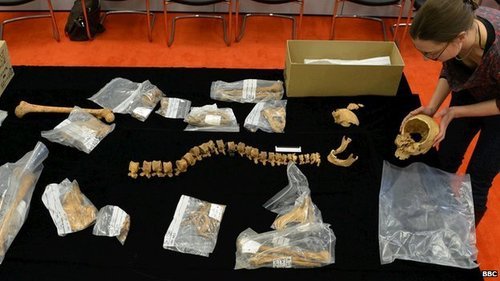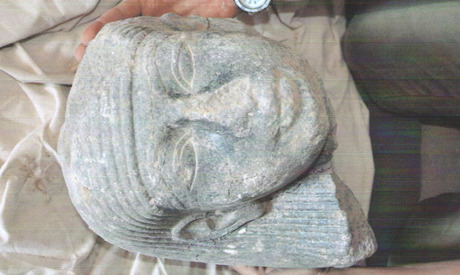
Year in digs: How 2013 looked in archeology
It has been another bumper year for scientific research and discovery, and plenty of it occurred in the field of archeology. Here is a selection of some highlights of the archeological year.
Read more.

Year in digs: How 2013 looked in archeology
It has been another bumper year for scientific research and discovery, and plenty of it occurred in the field of archeology. Here is a selection of some highlights of the archeological year.
Read more.

The Egyptian-Spanish archaeological mission unearthed on Thursday a large granite head of a statue of an unidentified New Kingdom king during routine excavation at King Thutmose III’s funerary temple on Luxor’s west bank. Mohamed Abdel-Maqsoud, head of the Ancient Egyptian Antiquities Section at the Ministry of State for Antiquities (MSA), explained that the head is 29.6cm high, 24.3cm wide and 26.9cm deep. The head depicts a round face of a royal figure, not identified yet, wearing a wig, with traces of a broken nose, and two long ears that each reach 8cm. The eyes, he continued, have traces of kohl, with thick eyebrows. Read more.
Plumbers fixing a water leak in central Portugal discovered what appears to be a cluster of 600-year-old Jewish ritual baths. The discovery was made earlier this year in the city of Coimbra as the plumbers were replacing the piping of an old building in what used to be the Jewish part of the Old City, according to a report Thursday by the Publico daily. Jorge Alarcao, an archeologist who was called upon to study the structures, told the paper: “This could be the only discovery of its kind made in Portugal.” The structures appear to be mikvahs, or ritual baths, predating the 14th century which were designed for Jewish women, according to Alarcao. Read more.
Ancient Maya Site Teeters on the Edge of Destruction
The Alacranes Bajo, a low-lying, highly fertile and productive stretch of land which extends across Belize’s northwest corner and parts of Mexico and Guatemala, has been farmed intensively for centuries by the ancient Maya. Today is no different, with its modern inhabitants continuing to clear the land.
One would think that this is a good thing. After all, agricultural development feeds people and can raise many a family out of the misery of poverty. But progress, particularly in Belize and its Central American neighboring countries, often comes at a steep price, as locations and resources that represent critical cultural heritage and undiscovered history are lost to the bulldozer and other human tools for development Read more.
.
The woman died more than 1,600 years ago, in what is now Jordan [...] in the ancient city of Zoar [her] tombstone, which is made of sandstone and is roughly the size of a legal pad, became their window to an ancient world centered in Zoar. Dr. Fine said that Zoar was “a major Christian city, a biblical pilgrimage city,” but that it had a sizable Jewish population. [...] Jewish tombstones from Zoar had been discovered in the early 20th century [...] 30 to 40 had been documented. [...] “ ‘Here rests the soul of Sa’adah, daughter of something.’ We don’t know the ‘something.’ ”Going by the format of other ancient tombstones, they felt certain the missing word was the name of the woman’s father and wondered if it was Phineas, but they said they could not be sure. “We have the P,” Dr. Fine said. “We thought there was an N, but we’re stuck because whatever it is, it’s been scratched away. You get to the point where ‘I can’t know’ may be the most learned answer you can give.”
New York stockbroker Eben Appleton inherited the Star-Spangled Banner upon his mother's death in 1878. The publicity that it had received in the 1870s had transformed it into a national treasure, and Appleton received many requests to lend it for patriotic occasions. He permitted it to go to Baltimore for that city's sesquicentennial celebration in 1880. After that his concern for the flag's deteriorating condition led him to keep it in a safe-deposit vault in New York. In 1907 he lent the Star-Spangled Banner to the Smithsonian Institution, and in 1912 he converted the loan to a gift. Appleton donated the flag with the wish that it would always be on view to the public.
 |
| The wisdom of the ancients |
Dr. Mara Mulrooney, assistant anthropologist at Bishop Museum in Honululu, conducted a six year study on Rapa Nui (Easter Island) concerning the island’s theoretical civilisation collapse. Her findings now challenge these previous ideas, which have claimed that the islanders “self-destructed” before Europeans first visited in 1722. Results from her doctoral dissertation are published in the December issue of the Journal of Archaeological Science. As popularised in Jared Diamond’s 2005 book Collapse, Rapa Nui is often viewed as a prime example of what happens when people lose sight of what they are doing to their environment. According to the popular narrative, the Rapa Nui people committed “environmental suicide” by deforesting their island home. However, Dr. Mulrooney and colleagues are starting to construct a more positive scenario. Read more.
It’s a mystery that has intrigued Americans for centuries: What happened to the lost colonists of North Carolina’s Roanoke Island? The settlers, who arrived in 1587, disappeared in 1590, leaving behind only two clues: the words “Croatoan” carved into a fort’s gatepost and “Cro” etched into a tree. Theories about the disappearance have ranged from an annihilating disease to a violent rampage by local Native American tribes. Previous digs have turned up some information and artifacts from the original colonists but very little about what happened to them. Until now. Read more.
 |
| Whose statues? |
the ancient stone statues at San Agustín are among the most mysterious pre-Columbian archeological artifacts. So far archeologists have discovered 40 large burial mounds containing 600 likenesses of mythical animals, gods and chieftains in what is South America’s largest complex of megalithic statues. Like other sites in the region, San Agustín has suffered plunder, both organized and freelance. Konrad Preuss, a German anthropologist who led the first European excavations there, shipped 35 statues that he found to a museum in Berlin, where they remain. This history has made the local inhabitants, who live from tourist visits to the site, suspicious. So it proved with a plan by the national museum to take 20 of the statues to the capital, Bogotá, a ten-hour drive away, for a three-month exhibition to mark the centenary of Preuss’s discovery of the site. Read more.
Multiple tombs lay hidden in Egypt’s Valley of the Kings, where royalty were buried more than 3,000 years ago, awaiting discovery, say researchers working on the most extensive exploration of the area in nearly a century. The hidden treasure may include several small tombs, with the possibility of a big-time tomb holding a royal individual, the archeologists say. Egyptian archeologists excavated the valley, where royalty were buried during the New Kingdom (1550–1070 B.C.), between 2007 and 2010 and worked with the Glen Dash Foundation for Archeological Research to conduct ground- penetrating radar studies. Read more.
Collapsing walls at the ancient Roman city of Pompeii have raised fresh concerns about Italy’s efforts to maintain one of the world’s most treasured sites, preserved for 2,000 years but now crumbling from neglect. On Monday, site officials said part of a wall had collapsed on one of Pompeii’s major streets after weeks of heavy rains and wind. Plaster had also fallen off the wall of the ornately frescoed House of the Small Fountain. A series of collapses in Pompeii over the last month led Italian media to dub it a “Black November” for the ancient city, preserved under ash from a volcanic eruption in 79 A.D. and rediscovered in the 18th century, revealing a time capsule of daily life in Roman times. Read more.This sort of thing is a recurring occurrence in all the cultural property retentionist countries of the developing world. They cannot cope with all the objects they obsessively hoard. This is clear proof that artifacts (particularly those of the Classical past) would be better off sent out of the country for safekeeping. Vast numbers of artifacts could be freed from dusty museum stores where they are hidden away, seen by nobody, and sold on the open market to raise funds to help protect what remains. No doubt Collectors and Museums in the United States, Europe and the Gulf States will be willing to lend their support and help.